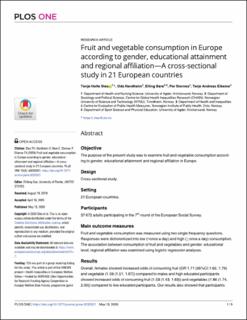| dc.contributor.author | Stea, Tonje Holte | |
| dc.contributor.author | Nordheim, Oda | |
| dc.contributor.author | Bere, Elling Tufte | |
| dc.contributor.author | Stornes, Per Gunnar | |
| dc.contributor.author | Eikemo, Terje Andreas | |
| dc.date.accessioned | 2020-05-22T08:09:07Z | |
| dc.date.available | 2020-05-22T08:09:07Z | |
| dc.date.created | 2020-05-20T12:18:17Z | |
| dc.date.issued | 2020 | |
| dc.identifier.issn | 1932-6203 | |
| dc.identifier.uri | https://hdl.handle.net/11250/2655282 | |
| dc.description.abstract | Objective The purpose of the present study was to examine fruit and vegetable consumption according to gender, educational attainment and regional affiliation in Europe. Design Cross-sectional study. Setting 21 European countries. Participants 37 672 adults participating in the 7th round of the European Social Survey. Main outcome measures Fruit and vegetable consumption was measured using two single frequency questions. Responses were dichotomized into low (<once a day) and high (≥once a day) consumption. The association between consumption of fruit and vegetables and gender, educational level, regional affiliation was examined using logistic regression analyses. Results Overall, females showed increased odds of consuming fruit (OR 1.71 (95%CI:1.62, 1.79) and vegetable (1.59 (1.51, 1.67)) compared to males and high educated participants showed increased odds of consuming fruit (1.53 (1.43, 1.63)) and vegetables (1.86 (1.74, 2.00)) compared to low educated participants. Our results also showed that participants living in Eastern Europe had the lowest odds of consuming fruit and vegetables, whereas participants from Southern- and Northern Europe had the highest odds of consuming fruit and vegetables, respectively. Results from interaction analyses confirmed the positive association between fruit and vegetable consumption and educational level, although for some European regions, decreased odds of fruit and vegetables was observed among medium educated participants compared to those with low education. Conclusions Overall, the present study showed that being female and having a high education were associated with increased consumption of fruit and vegetables. However, the direction and strength of these relationships depends on regional affiliations. | en_US |
| dc.language.iso | eng | en_US |
| dc.publisher | Public Library of Science | en_US |
| dc.relation.uri | https://journals.plos.org/plosone/article?id=10.1371/journal.pone.0232521#ack | |
| dc.rights | Navngivelse 4.0 Internasjonal | * |
| dc.rights.uri | http://creativecommons.org/licenses/by/4.0/deed.no | * |
| dc.title | Fruit and vegetable consumption in Europe according to gender, educational attainment and regional affiliation—A cross-sectional study in 21 European countries | en_US |
| dc.type | Peer reviewed | en_US |
| dc.type | Journal article | en_US |
| dc.description.version | publishedVersion | en_US |
| dc.source.journal | PLOS ONE | en_US |
| dc.identifier.doi | 10.1371/journal.pone.0232521 | |
| dc.identifier.cristin | 1811895 | |
| dc.relation.project | Norges forskningsråd: 228990 | en_US |
| dc.description.localcode | © 2020 Stea et al. This is an open access article distributed under the terms of the Creative Commons Attribution License, which permits unrestricted use, distribution, and reproduction in any medium, provided the original author and source are credited. | en_US |
| cristin.ispublished | true | |
| cristin.fulltext | original | |
| cristin.qualitycode | 1 | |

